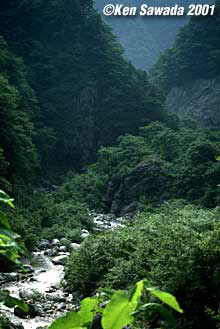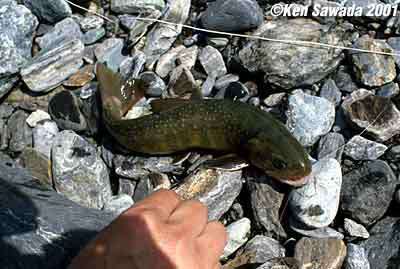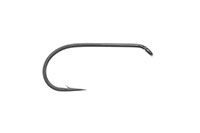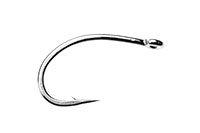
Mountain Streams --Vol.14--

When we use dry flies we can see a fish coming near. Then we are apt to set the hook to it too early.
Put the Fly into the Fish Mouth and you will Hook up its Jaws
After catching three char in the lower pool of the Kimpusan River with an ordinary fly in an ordinary way, I went back to the upper pool. I believed that there was no fish except for a shameless char but, unexpectedly, innocent char appeared successively. I was really ashamed of my experiment of my epoch-making flies (mentioned in vol.13) but it gave me precious advice about my future fishing.In order to hook the jaws of fish, the hook has to go into the fish mouth. When the hook does not go into the mouth or goes into it only a little, hooking is absolutely impossible. For good hooking, the hook should be put into the mouth deeply. That means the fish has to swallow the whole fly. I should have improved a fly shape so that fish swallowed the whole fly at a gulp, instead of changing it so that fish bit the fly once they touched it. In addition, whether fish swallow the whole fly at a gulp depends on not only a fly shape but also the whole process of fishing.
When I first read "A Fly Fisher's Life" by Charles Ritz, I found a passage where he meant that it was more influenced by presentation than by fly pattern whether fish bit the fly or not. In those days most anglers were doubtful about his words but I realized through my experiment that he was quite right. Later I devoted myself to casting as well as fly tying and visited him to ask for a piece of advice. I also involved myself in improving various tackles. By taking up all these activities I aimed at developing my presentation skills. Since then my effort has still continued.

Crystal-clear water flows at Nishinomata in the Kimpusan River. When we see a char coming near to the fly slowly, we cannot wait for enough time but are apt to set the hook to it too early.
Fish that Play with the Fly
I think that different kinds of fish move in very different ways when they jump at the fly. If we fish one kind of fish for many years, our fishing style will be changed into a suitable one for that kind. Particularly, the timing of setting the hook to the fish is quite different according to fish kind, fishing method, fly type, average size of the fish or the condition of fishing spot. Therefore, anglers never reach an agreement as far as each of them has got different fishing style. Since they try to fish a different kind of fish in a different method, they are not birds of a feather just because all of them are fly fishermen.
Each fish jumps at the fly at a different speed. We have to watch the fly carefully until it disappears into the fish mouth whether the fish moves at a high speed or not.

The source area of the North Japan Alps. Most of char come near to the fly slowly.
Most anglers who fish yamame trout with Japanese traditional style fly might think that they are the fastest fish. Their move is most often described as lightening speed. Do they really move so fast? I do not deny that they usually jump at the fly at a high speed but I think it is only true of small sized ones. When I fish large sized yamame trout I have never felt they move fast. I have rather felt they move impatiently slowly.
As for the speed of jumping at the fly, Tiny fresh water minnows (white minnows, Shirahae fish) seem to move much faster than yamame trout. But I feel the speed problem is highly influenced by fish appearance as well as how fast they really move. Protecting colouring fish whose colour or shape is hard to notice are seldom seen coming near to the fly, so we suddenly found them swimming very near to the fly or already jumping at it. Then those fish are often considered to be fast moving. On the other hand, noticeable fish can be found before they come near to the fly. So we can spend enough time to set the hook to them, however quickly they jump at the fly. Those fish never seem to move fast.
We are apt to set the hook to noticeable fish too early, whereas setting it to unnoticeable ones too late. I think those tendencies are confused with slow or fast move of fish.

This char came up to size 10 fly like a snake and swallowed the whole of it.
Besides different speed, fish behave differently when they bite the fly or come near to it. Yamame trout often play with the fly while they are young and small, as if they were kittens. It is clear that they play with the fly even when they do not want to eat it. As they grow up they have the sense of territory like sweet fish and try to exclude an offensive intruder. Even if the intruder is not a fish they behave in the same way. To be more mysterious, they sometimes bite what they know is not bait. They bite and even swallow a leaf, a grain of sand or a twig. I saw a large sized rainbow trout in Lake Ashinoko in Hakone swallow many cigarette butts. Then I once wondered if they could hardly tell bait from non-bait. But now I think that they might swallow it, knowing it is not bait. Anyway, it is only fish that can give a correct answer.

A char in a big artificial waterfall in the Kimpusan River. It responds very differently according to how the fly drifts, as if it were another creature.

A raging waterfall in the South Japan Alps. When the water is too dark to see through, we can manage without being cheated by the fish move.
Playing fish sometimes bite the fly but more often they butt it with their nose, bang into it full force, jump over it or hit it with their tail. They do those activities very quickly, so inexperienced anglers cannot tell a bait-biting fish from the others. In spite of setting the hook without a moment's delay, they fail in hooking up the jaws of fish. Such experience makes them think that they set the hook too late and drives them to set it much earlier. That is what most anglers have once experienced. On the contrary, if they give up setting the hook, they will see the fly floating forever. Finally, even if they manage to set the hook to a fish, they will find the fly has caught the side of the fish. Through those experiences anglers can understand how fish move.
Jumping Yamame trout vs. Stopping Char
Not only playing fish but also other fish behaviours embarrass anglers. Imagine that a fish first dashes to the fly and suddenly changes its move as if changing its mind or imagine that a fish has no desire to eat the bait from the first. If that fish is a yamame trout, it will jump over the fly or pass by it. Most of rainbow trout will turn over just in front of the fly. A char will stop suddenly. Anglers need a lot of experience to read such fish move. It is important to watch only the fly and not to be cheated by the fish move. Even if a fish splits the water and jumps, or even if it dashes to the fly, it does not matter at all. Never set the hook to the fish until the fly touches the fish and disappears in its mouth completely. It is not uncommon that fish that once stopped change their mind and bite the fly a moment later. But if you try to set the hook early you will never grab a chance.-- To be continued --
- NET SHOP INFORMATION

SL6 Black Spey Hooks

DU3 Limerick Spinner Hooks

SL4 Single Bartleet Hooks

XD1 Tube Fly Double Hooks

DD2 Flat Perfect Hooks

DD1 Black Terrestrial Hooks

TD4 Old Limerick Wet Hooks

DU1 Silver May Hooks

MU1 Flat Midge Hooks

LD3 Long Limerick Hooks

TD2 Summer Sproat Hooks

XS1 Tube Single Silver Hooks

TD6 Siver Sedge Hooks

SL5 Black Spey Hooks

DU3 Limerick Spinner Hooks
- TROPHY CLUB
- FLY SHOW
- EXHIBITION
- MASTERS`
- FLY DRESSING CONTEST Archives
- TRAVELLER Archives
- TACKLE IMPRESSIONS Archives
- ANGLERS` PHOTO GALLERY Archives
- ----------------------------------------------
- トロフィークラブ
- フライショー
- エキシビション
- マスターズ
- フライドレッシング・コンテスト・アーカイヴ
- トラヴェラー・アーカイヴ
- タックル・インプレッション・アーカイヴ
- アングラーズ・フォトギャラリー・アーカイヴ
株式会社サワダ 185-0021 東京都国分寺市南町3-13-4
SAWADA'S INC. 3-13-4 Minamicho, Kokubunji, Tokyo 185-0021, Japan
写真・ドキュメントの無断転載を禁じます。
All the images and documents found on this site are owned by Ken Sawada and may not be used without permission.
But, link to this site is FREE.
Copyright © 2000 - 2024 SAWADA'S INC.. All rights reserved.
SAWADA'S INC. 3-13-4 Minamicho, Kokubunji, Tokyo 185-0021, Japan
写真・ドキュメントの無断転載を禁じます。
All the images and documents found on this site are owned by Ken Sawada and may not be used without permission.
But, link to this site is FREE.
Copyright © 2000 - 2024 SAWADA'S INC.. All rights reserved.
